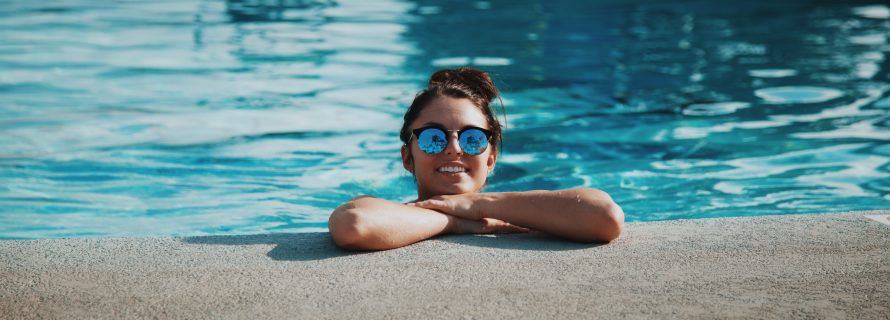Swimming Pool Leaks: Basic Guide for Pool Owners

Having a pool at home is exciting. When you have one, you can look forward to a long list of seasonal fun planned both with family and friends. However, did you know that the average in-ground pool costs between $10,000 and 100,000? That’s a massive investment!
That said, owning a pool can require a certain degree of commitment that goes beyond keeping it clean. You also need to make sure you keep an eye out for any possible signs of a leak. Pool leak detection is crucial since leaks are one of the leading causes of structural damage.
Your Essential Guide to Swimming Pool Leaks
Below are some of the obvious (and not so obvious) signs that point to a possible pool leak:
Water Loss
Water loss is hands down one of the most significant indicators of a pool leak. However, you need to keep in mind that you are likely to lose some water on hot days due to evaporation. But if you notice that water in your pool is getting lower than usual, consider it your cue to look for other signs of a possible leak to confirm your suspicion.
Visible Cracks
Visible cracks often start as small cracks or pinholes. At times, the gaps are so small that they’re barely noticeable.
Higher Water Bills
If water is seeping out due to a leak in your pool, you’ll surely notice it the next time you get your water bill.
Air in the System
If you notice air bubbles coming out of your pool’s return tiles, you likely have a leak in your pool’s filtration system.
Pool Deck Lifting or Sinking
Leaks that happen underground can result in pooling water that can end up damaging your pool deck. Unfortunately, some mistake the damage as wear and tear rather than a possible sign of a leak.
Inconsistent pH
If you find it challenging to keep your pH balanced, it is also a clear indicator of a possible pool leak.
Leak Detection Tests
There are a few leak detection tests you can carry out before bringing in a pro. Some of the leak detection tests you can do to confirm your suspicion include:
The Evaporation Test
Fill a bucket with water and place it on the deck next to your pool. Using indelible ink, mark the level in the bucket. Do the same thing in your pool. Turn off the circulation after. After a few days, mark the new level in the bucket and pool.
Both the bucket and the pool should have the same level of evaporation. If the pool level is significantly more, then it’s time to call in a professional.
The Dye Test
Brush and clean your pool carefully and pay special attention to the corners, fittings, and steps. To increase visibility, squirt tile soap across the surface. Look for cracks starting at the tile line. Tap the tiles gently to see if they are loose or if they sound hollow.
Squirt food dye in areas where you suspect leaks, then enter the pool and squeeze the dye. If you notice swirling around the suspected crack, then there’s no leak. However, if the dye gets sucked in, it is riding on a flow of water that leaks from your pool.
Still Can’t Find the Leak?
There are instances when a DIY approach just won’t cut it. In similar cases, you need to bring in experts with specialist equipment. Some of the techniques they will use include:
Pressurizing
Using compressed air, your pipes will be pressurized to see where air pressure falls along your pipes. Pressurizing will also force the bubbles from compromised areas. This makes leaks easier to identify.
Camera
Experts may also use a television camera to locate the leak. They can also use a very sensitive microphone to listen to water escaping from the leaks.
Conclusion
Pool leaks are not easy to find. If you suspect you have a pool leak but unsure how to find it, don’t shy away from investing in the help of a professional. While you will need to spend money, at least you are sure things are handled accordingly and any issues are addressed before they require costly repairs.
About the Author: Anthony Quinn is the Marketing Strategist of Phoenix Leak Detection. Aside from the marketing aspects of the business, he is also in charge of reaching out to residential and commercial property owners to look into their leaking problems. When not writing, he plays golf with his friends and colleagues.
Photo by Conner Baker on Unsplash
- Additions and New Construction
- All Exteriors
- Alterations
- Basements
- Bathrooms
- Customer Service
- Customer Stories
- Decks
- Design & Planning Show
- DIY
- Doors
- Educational Resources
- Extreme Makeover Home Edition
- Fashion Show
- General Remodeling
- Green Living
- Handyman Home Services
- Home Decor
- Home Entertainment
- Home Improvement
- Home Improvements
- How to Tips
- In The Community
- Kitchens
- Off-the-Wall Remodeling Stories
- Remodeling
- Resources
- Roofing
- Siding
- Social Media
- Sunrooms
- Tips & Tricks
- Trends
- Windows

